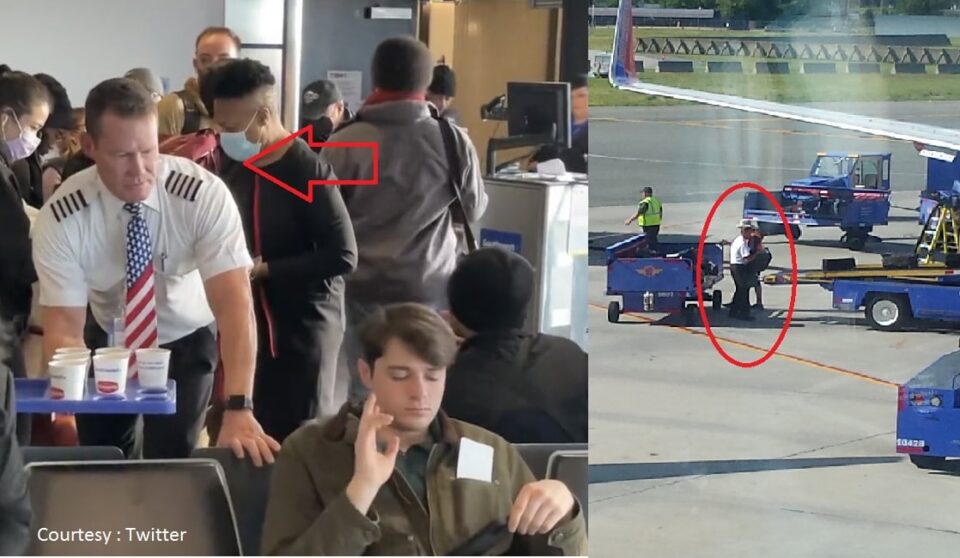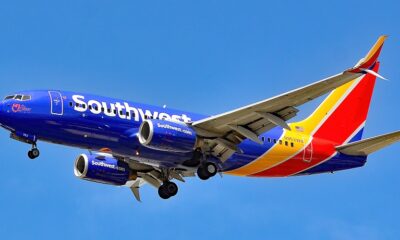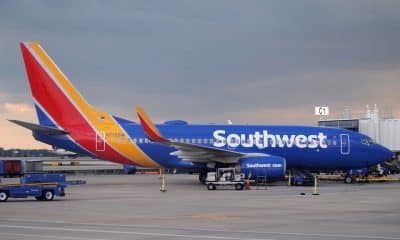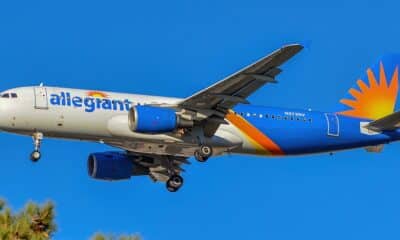Aviation
Southwest Airlines’ two pilots are winning the internet after the airline received intense backlash for cancelling flights.

Southwest Airlines, the leading low-cost airline in the USA, has been dealing with complaints from passengers since the start of the major Christmas season last week. However, there is no proper connection to airlines. Due to the intense snowfall in some areas, the majority of airlines suspended operations. 70% of the flights were canceled because the airline was unable to handle the demand and because the airport’s capacity was much exceeded by the number of passengers and the volume of luggage.
The unhappy passengers demanded that it arrive promptly for the next trip that was available. and decreased customer service as a result of the canceled flight, which angered the passengers.
However, on Friday, everything returned to normal, as stated by the airline CEO. But by making thoughtful gestures and assisting passengers in boarding, airline pilots have won the hearts of their passengers. Last week, a pilot was witnessed loading bags onto an airplane alongside ground personnel, and several of the passengers reacted negatively to him. All of the Southwest employees are back at work and doing their utmost to rebook the flight.
@SouthwestAir best pilots I've seen. Pilot 1 pushing a wheelchair in board as he gets on. Pilot 2 loading bags pic.twitter.com/HjwOFkUeMO
— nandini bissessar (@nandinibg) June 22, 2017
Another pilot was observed serving coffee to passengers, and the internet is praising this wonderful gesture. The pilot said, “We’re trying, folks,” and everyone applauded his gesture. On Twitter, the video was posted with the comment, “On a flight from Baltimore to Louisville, a @SouthwestAir captain offers coffee to passengers who are running behind schedule. As everyone waited for substitute flight attendants, he addressed the crowd and said, “We’re trying, folks,” to a few cheers from the audience.” With over 1.2 million views as of right now, the video has become extremely popular.
A @SouthwestAir pilot hands out coffee to delayed passengers on a flight from Baltimore to Louisville. “We’re trying folks,” he told the crowd to a smattering of applause as everyone waited for replacement flight attendants. #Southwest pic.twitter.com/fmMAqS4cck
— Eric Flack (@EricFlackTV) December 27, 2022
Southwest has also made it clear that it will reimburse all passengers for canceled flights and offer them the chance to rebook at the airport.
Customers disrupted by our operational challenges who have questions about flight refunds, alternative travel arrangement reimbursements, or locating displaced luggage, please follow the link below.
— Southwest Airlines (@SouthwestAir) December 31, 2022
Southwest Airlines recently landed in trouble with the US government after the cancellation of thousands of flights during the winter storm. The carrier was blamed for 60 percent of the total cancellations of flights in the USA. Amidst all this chaos, an airline pilot has gone viral on the internet for serving coffee to passengers stranded at an airport after their flight got canceled. The gesture of the pilot towards the troubled passengers during the holiday season is being appreciated on the internet. Among the people appreciating the pilot is Jet Airways CEO Sanjiv Kapoor.
The Jet Airways CEO is an avid social media user and never backs from expressing his views on certain matters. The aviation expert praised the pilot as well as the passengers, who applauded his warm gesture. As per the details on social media, the video was originally shared by Eric Flack on Twitter, showing the unnamed pilot serving coffee to passengers at Baltimore/Washington International Thurgood Marshall Airport. However, the pilot was not alone in the endeavor. He was followed by another person carrying milk and sugar

Aviation
South Korea Introduces Cutting-Edge MRO Center for F-35 and IAI

South Korea is set to make waves in the aerospace industry with the establishment of a cutting-edge Maintenance, Repair, and Overhaul (MRO) hub for F-35 fighter jets and IAI (Israel Aerospace Industries) aircraft.
Central to this initiative is the specialization in converting Boeing 777-ERSF, colloquially known as the “Big Twin,” from passenger to freighter configurations. Under the terms of the agreement, IAI will spearhead the conversion of six B777-300ER and B777-200LR aircraft annually, commencing in 2024. This strategic move is in response to the anticipated surge in demand for wide-body freighter aircraft capable of long-haul flights.
Furthermore, South Korea’s forward-looking vision extends beyond aircraft conversion, with plans to establish a Lockheed Martin F-35 maintenance, repair, and overhaul depot at Cheongju Air Base by 2027. This strategic move not only enhances the operational readiness of South Korea’s air force but also positions the nation as a regional hub for F-35 maintenance expertise.
In preparation for this expansion, thirty Republic of Korea Air Force (ROKAF) engineers and technicians are slated to undergo intensive maintenance training in the United States in 2025, a testament to South Korea’s commitment to fostering local expertise and talent.
IAI’s visionary approach to certification and collaboration underscores the potential for transformative change. With plans for the 777-300ERSF certification process set to unfold in Israel, followed by the rigorous scrutiny of regulatory agencies such as the US Federal Aviation Administration (FAA), the stage is set for the ‘Big Twin’ to soar to new heights of success.
In partnership with esteemed entities like STK and Incheon International Airport Corporation, this collaboration promises to unleash a wave of benefits, amplifying the resilience and competitiveness of the Korean aviation sector while catalyzing job creation and economic prosperity.
Aviation
Lockheed Martin Expresses Interest in Joining AMCA Project

Lockheed Martin, a leading global aerospace and defense company, is demonstrating its dedication to strengthening collaborations with India’s research, industry, and academic sectors. With its rich experience in the aerospace industry and renowned for building some of the world’s most advanced jets, Lockheed Martin is now exploring opportunities to contribute to India’s aerospace sector, potentially providing a significant boost to aerospace technology in the country.
Randy Howard, Vice President of Global Pursuits at Lockheed Martin Aeronautics, recently underscored their interest in exploring “advanced transfer of technology opportunities” with Indian partners, signaling a proactive approach towards fostering technological exchange and advancement in the aerospace domain.
India has been at the forefront of fighter jet development since the 1970s, having produced its own cost-effective fighter jets and combat helicopters, while continually upgrading to maintain competitiveness on a global scale.
Lockheed Martin stands as a dominant force in the aircraft industry, renowned for developing cutting-edge planes like the F35 and F22, some of the most advanced fighter jets globally. They’ve also contributed to projects like the South Korean KF21 aircraft for defense purposes through collaborations.
Now, Lockheed Martin has set its sights on India’s defense sector manufacturing processes, expressing interest in partnering with India on its most anticipated project, the Advanced Medium Combat Aircraft (AMCA), likely to be a 5th generation fighter jet for the Indian military.
Their proposed collaboration could involve a spectrum of advanced technologies, including the Auto Ground Collision Avoidance System (Auto GCAS), a life-saving technology that intervenes to prevent ground collisions, thus significantly enhancing flight safety for Indian pilots.
Lockheed Martin is extending its expertise to design and develop an indigenous cockpit for the F-21 fighter jets, which India is procuring. This collaboration with Tata also includes the development of fighter jet wings. Established in 2023, this partnership adopts a “Ground Floor Design” strategy aimed at equipping India with an in-depth comprehension of 5th-generation cockpit technology and Man-Machine Interface (MMI) systems.
As India’s Fighter jet program advances with finalized aircraft frame and engine prototypes, Lockheed Martin has expressed interest in joining the project. They see a groundbreaking opportunity in cooperative 5th Generation Fighter Development, potentially expediting the AMCA program’s progress through technology and expertise sharing.
Furthermore, Lockheed Martin is keen on collaborating on large-wing, jet-powered UAV platforms, which could enhance India’s unmanned aerial capabilities.
While discussions are ongoing, and specific collaboration details await finalization, this initiative represents a potentially transformative stride in India’s aerospace self-reliance journey and Lockheed Martin’s strategic engagement with the Indian market.
Aviation
Can Airline Seat Cushions Be Used As Life Jackets?

In the event of an aircraft ditching into water, there’s a common question: Can aircraft seats serve as an alternative to life jackets for flotation? The answer lies in understanding their respective functions.
While seat cushions can provide some buoyancy in water, they are not intended nor certified to function as life jackets. Their primary purpose is to offer cushioning for passengers during flight. On the other hand, life jackets are meticulously engineered to keep individuals afloat in water, equipped with buoyancy materials, secure straps, and reflective elements for visibility. They offer numerous advantages over mere cushions.
While a seat cushion might offer temporary assistance in staying afloat, it’s not a dependable substitute for a proper life jacket during an emergency. It’s crucial to utilize approved safety equipment when near bodies of water. A life jacket, designed to keep a person buoyant for extended periods, offers the rigidity needed for prolonged flotation and allows for easy movement of the arms to navigate effectively.
What fabric is used in aircraft seats?
Seats are meticulously designed to fulfill multiple purposes, ensuring passenger comfort, safety, and protection from unforeseen circumstances like fires and accidents. A typical design incorporates an aluminum frame with blocks of polyurethane foam affixed to it. Additionally, a layer of fire-resistant fabric, such as Kevlar or Nomex, is often applied over this framework, topped with a layer of cloth or leather.
Leather seats, while luxurious, are more expensive compared to traditional cloth seats. The majority of fabrics used in seat upholstery contain at least 90% wool fiber, with the remainder typically consisting of polyamide (nylon). Wool stands out as the primary fiber chosen for commercial airline seating fabric due to its desirable properties and suitability for such applications.
What is the lightest economy seat?
In recent times, airlines have been downsizing seat dimensions to accommodate more passengers, resulting in reduced cushion length and leg space. This contrasts with earlier times when airlines offered more generously cushioned seats and ample amenities.
According to Recaro Seats Company, their SL3710 model represents the lightest economy class seat available, weighing in at a mere 8 kg (17.6 lb.), setting a new standard in aircraft seating.
For individuals weighing more than 350 pounds, fitting into a standard economy-class seat can be a challenge due to the narrower dimensions. Economy seats, also referred to as “coach,” “standard,” or “main cabin” seats, typically range from about 40 to 48 centimeters in width, further emphasizing the need for more accommodating seating options.



























